|
~~ Naval ~~ |
||||||||||||||||||||||||
|
Index for Russo Japan War, 6 Volume Set |
||
| Naval | Yalu & Karafuto Armies | First Army |
| Second Army | Third Army | Fourth Army |
|
|
||
| Covers | Colophons | Statistics |
|
|
||
|
Return to the K. Ogawa Main Page
For information on a similar 2 volume set, Click here. |
||
|
|
||
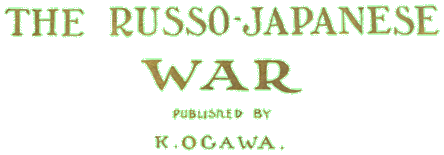
The Russo-Japanese War:
Naval, By Permission of the Naval Department
Published by Kazumasa Ogawa, 1905
Part of a Six Volume Set
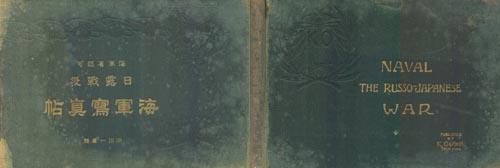
Naval Volume
Ogawa, K. (Kazumasa) (Publisher)
The Russo-Japanese War: Naval, By Permission of the Naval Department, Tokyo, ©1904 by T. Ichioka and published by K. Ogawa, printed and distributed in 1905, large oblong 4to (14 3/4 x 10 in - 37.5 x 25.5 cm), green blindstamped covers with gilt titles (boards and spine), listing of plates ("contents") and 9 pages of text in English titled "Operations of the I.J. Navy in the War" and 10 pages of Japanese text plus 120 unnumbered pages of photographs. The book contains 131 images (a few plates have multiple images) on 120 full page plates. All plates are black and white halftone photographs. Each page has an English caption and Japanese descriptive notes. The English text section traces the Operations of Admiral Togo's fleet, as it engaged the Russian Navy, from February 11, 1904 through May 28, 1905. It documents the Naval battles with the Russian fleet by the Japanese fleet during this period.
Title Pages
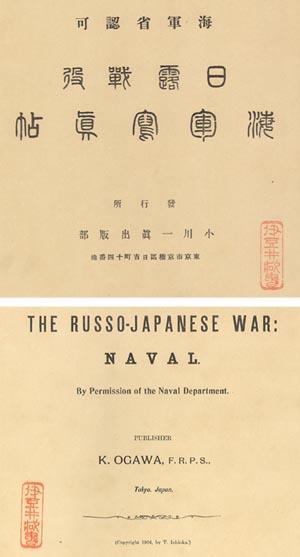
Major sections in the English text:
- The First Mid-Night Assault at Port Arthur (February 1904)
- The Battle of Chemupo (February 1904)
- The Battle of the Yellow Sea (August 1904)
- The Battle of Ulsan (August 1904)
- The Battle of the Sea of Japan (May 1905) (in great detail including an appendix of Russian vessels involved and their status - 30 Russian vessels participated of which only two escaped with over 22 sunk).
The 120 photographic plates document the above Naval actions, the men and ships involved and the return of the Fleet and Admiral Togo's "triumphal return to Tokyo on the 22nd October, 1905."
A Note Regarding the Plates. Mottling on plates is typical in this set. While the plates do not appear damaged, there are scattered areas where the high gloss of the plate paper is dull rather than shiny. You don't notice this when looking directly down on the image. However, when you view the plates looking across towards a light source, you see scattered areas of mottling/dulling on the glossy off-white plate pages. This appears to be a normal aging process of the glossy paper. The text pages which are not the same high gloss paper do not have the mottling.
The same book was sold separately in a blue cloth cover. The colophon of that book indicates a printing date of December 22, 1905 (Meiji 38) where this book indicates a printing date of November 22, 1905 (Meiji 38). Aside from different covers and printing dates, the books are the same. All text and photographs are idenentical. For more information on the stand-alone book, click here
For information on Kazumasa Ogawa, click here.
Complete Set of 6 VolumesThe Russo-Japanese War: A six volume set with continuing titles that read:
A matching set of 6 volumes, printed and distributed in 1905-6, large oblong 4to (14 3/4 x 10 in - 37.5 x 25.5 cm), green blind stamped covers with gilt titles (boards and spine), Tokyo, Naval volume copyrighted by T. Ichioka, 1904, Army volumes copyrighted by the Military Survey Department, 1904. An extensive photographic survey of the War dedicated to the First to Fourth Armies, the Armies of the Yalu and the Karfoto, and the Navy. The plates, which have descriptive captions, are supplemented by text pages (in English and Japanese) which reflect official Japanese military reports regarding the operations of the Navy and Armies in the Russo-Japanese War. The text accounts run in chronological order and recount the significant battles, operations and activities. In total the set contains 856 black and white halftone plates (736 - Army & 120 - Navy) produced by K. Ogawa, 136 pages of text in English, 123 pages of text in Japanese. Of the 856 plates, 11 plates fold-out and 14 plates have tissue overlays with descriptive information in Japanese. There is one loose map with the set. All 6 books have the same basic format. When read Western style, from front to back, the front cover is in English. It is followed (all in English) by the title page, the "Imperial Proclamation of War," text pages and finally a listing of plates. The English section ends next to last plate in the book. When read Japanese style, from back to front, the cover is in Japanese. It is followed (all in Japanese) by a title page, portrait plate(s) of Imperial family members in the military and key military members, the "Imperial Proclamation of War," text pages, a listing of plates in Japanese, and the plates with the last plate adjoining the end of the English portion of the book. All plates have descriptive captions in Japanese above the image and in English below the image. Plates in the Army books are numbered and there are plates (plates right after the title page) not included in the numbers. The plates are generally, but not always, printed back to back. The image area is approximately 7 x 10 in. The Army books share common plates (generally 10). These plates relate to the "Triumphal Return" of the Armies in Manchuria (8 plates at the back of the numbered plates) or they are portraits of commanders (2 plates at the front of the book). It is clear that the books were edited to not present images of horrors of war. I find very few plates that show the actual human carnage or death on the battlefield. In general the images show battles in progress, important locations, key terrain, key figures (both Japanese and enemy), captured ordnance and munitions, troops in combat and at rest, prisoners of war, first aid stations and hospitals, ships and military equipment and an occasional dead horse.
|
Illustrations in this Volume
(All Black & White Halftone Images)
- Frontis Portrait plate.
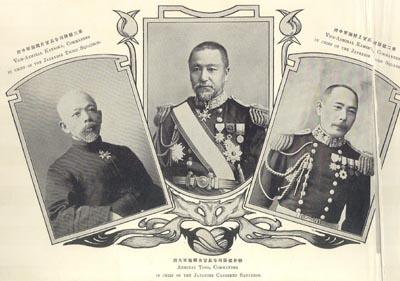
- A first class battleship.
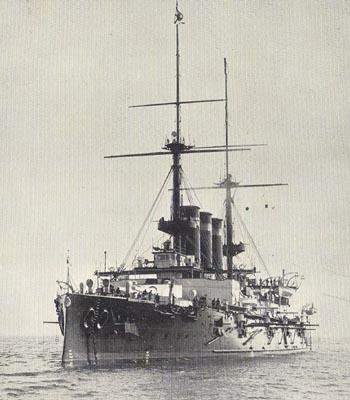
- Interior of the cabin of a first-class battleship.
- Warships at a Naval Base. No. I.
- Warships at a Naval Base. No. 2.
- Sunset at Naval Base.
- The main battleship squadron on blockading duty outside Port Arthur.
- The main battleship squadron blockading Port Arthur in rough weather.
- Vedette-boats returning to the Naval Base after a reconnaissance in force.
- Torpedo-boat flotilla returning to the Naval Base after a night attack.
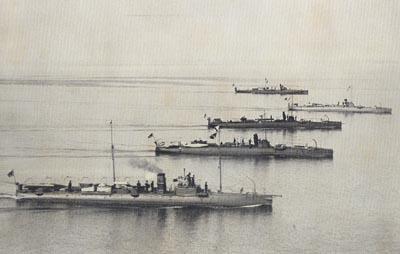
- A battleship cleared for action.
- The first shot fired by the main squadron in the GreatBattle off Port Arthur, l0th August, 1904.
- Firing a 12" gun.
- Firing 6" quick-firing gun.
- Searchlights.
- The main battleship squadron steaming towards the enemy.
- Explosion of a mechanical mine.
- Warships dressed up on His Majesty's Birthday.
- A first-class cruiser at full speed, chasing an enemy's merchant ship.
- Battleship "Mikasa," the Flagship of Admiral Togo.
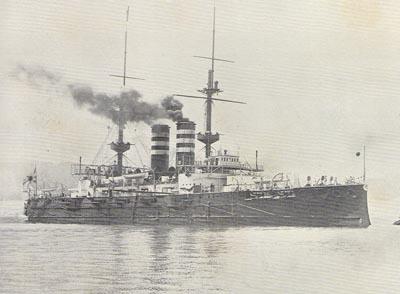
- Interior of the heavy gun battery at the Imperial Naval College.
- Our squadron off Port Arthur watching the enemy.
- Firing a Nordenfeldt machine gun.
- Second-class battleships " Fuso " and " Chinyen."
- First-class baitleship "Fuji."
- First-class battleship "Hatsuse."
- First-class battleships "Asahi" and " Yashima."
- First-class cruiser "Kasuga."
- First-class cruiser "Yakumo."
- First-class cruiser "Iwate."
- First-class cruiser "Idzumo."
- Admiral Baron Yamamoto, Minister of the Navy, Vice Admiral Saito, Vice-Minister of Navy, Admiral Viscount Ito, Chief of the Naval Commanding Staff (3 views) [Not listed in the Contents]
- The Great Naval Fight of the Yellow Sea on the l0th August, 1904.
- Flagship "Mikasa" and vedette-boats.
- Torpedo-boat destroyer squadron outside Port Arthur.
- A torpedo-boat destroyer.
- A torpedo-boat destroyer towing a captured smuggling junk.
- The first shot fired by the Russians on the l0th August, 1904.
- A Russian mechanical mine.
- Vedette-boats on duty for a reconnaissance in force.
- A Naval Base.
- Firing a 47-mm. quick-firing gun.
- A land gun at a Naval Base.
- A submarine torpedo-boat.
- Torpedo-boat flotilla and torpedo-boat No. 58. (2 images)
- Torpedo-boat flotilla and torpedo-boat No. 56. (2 images)
- Torpedo-boats Nos. 12 and 57. (2 images)
- Torpedo-boat destroyer "Yugiri."
- Torpedo-boat destroyer "Kagero."
- The first-class cruiser "Nisshin."
- The first-class cruiser "Tokiwa."
- Torpedo-boat destroyer "Shinonome."
- Russian warships sunk in the West Basin of Port Arthur.
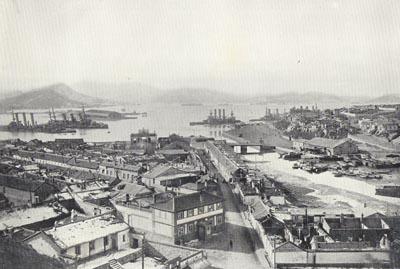
- Russian cruiser "Pallada" and battleship "Pobieda" lying at the Fort of the Golden Hill.
- A Japanese shell falling into the dock and East Basin of Port Arthur.
- Russian battleship "Retvisan" sunk at Port Arthur.
- Russian battleship "Poltawa" sunk at Port Arthur.
- Sunken gun-boat "Giliya " and the broken military mast of a wrecked battleship, at Port Arthur.
- Sunken gun-boat "Giliyak."
- Three Japanese blocking Ships sunk in front of the Tiger's Tail.
- Japanese blocking Ships near the Golden Hill.
- Launching of the first-class battleship "Kashima."
- Manoeuvres of our fleet. No. 1.
- Manoeuvres of our fleet. No. 2.
- Full speed manoeuvres of our fleet.
- Manoeuvres of our fleet. No. 3.
- Manoeuvres of our fleet. No. 4.
- Frozen bow of a cruiser of the Kamimura Squadron on its way to the bombardment of Vladivostok early in March, 1904.
- Great Naval Fight on the 14th Aug., 1904 between the Kamimura and Vladivostok Squadrons.
- Survivors from the "Rurik" being clothed on the board a Japanese cruiser on the 14th Aug., 1904.
- Floating ice in Kunashiri Strait.
- A cruiser forcing its way through ice in the North Sea of Japan. No. 1.
- A cruiser forcing its way through ice in the North Sea of Japan. No. 2.
- Capture for a smuggling merchant ship in the North Sea of Japan.
- Torpedo-destroyer "Sazanami" which captured admiral Rodjestvensky and his staff on the 28th May, 1905.
- A signalman with his megaphone. Measuring a distance with a barr and strand range-finder. (2 images)
- Hoisting of the Japanese flag on the Russian battleship "Orel" which surrendered on the 28th May, 1905.
- Russian battleship "Nicolai I" which surrendered in the Great Naval Battle of the Japan Sea on the 28th May, 1905.
- Surrender of the Russian men-of-war under Admiral Nebogatoff in the Great Naval Battle of the Japan Sea on the 28th May, 1905. No. 1.
- Surrender of the Russian men-of-war under Admiral Nebogatoff in the Great Naval Battle of the Japan Sea on the 28th May, 1905. No. 2.
- Officers of the "Orel" on board the "Asahi" on the 28th May, 1905.
- The "Orel" which was captured in the Great Naval Battle on the 28th May, 1905 and renamed "Iwami" under the Japanese flag.
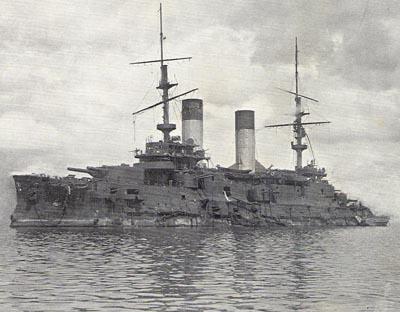
- The "Orel" after the Great Naval Battle of the 28th May, 1905.
- A damaged gun of the "Orel."
- A shot hole on the "Orel."
- Another shot hole on the "Orel."
- Damages on the portside of the "Orel."
- Damages on the boat deck of the "Orel."
- Damages on the portside upper-deck of the "Orel" No. 1.
- Damages on the portside upper-deck of the "Orel" No. 2.
- Damages on the upper deck of the "Orel."
- Damages on the shelter dock of the "Orel."
- A Group of Senior Admirals with Their Staffs, Taken on Admiral Togo's Triumphal Return on the 22nd Oct., 1905 (with a tissue overlay displaying the profile of the individual and name in Japanese on the profile for identification - opposite the picture is foldout sheet with Japanese writing, front and back. The back of this sheet is a map of Yokohama harbor. It has in English writing the title "Yokohama Offing Showing the Positions of the Fleet for Review on It's Return from War" with a schematic (in Japanese)of the placement of ships on the map). [Neither the plate or the foldout is listed in the Contents].
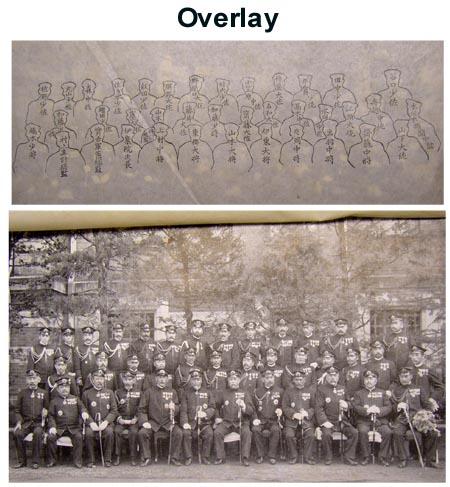
- A general view of the Grand Naval Review in Tokyo Bay on the 23rd October, 1995. (foldout plate with internal tissue guard)
- Admiral Togo's triumphal return to Tokyo on the 22nd October, 1905. No. 1.
- Admiral Togo's triumphal return to Tokyo on the 22nd October, 1905. No. 2.
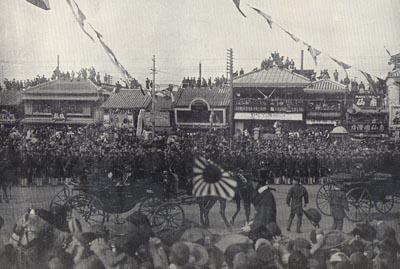
- The Triumphal Arch at Shimbashi and its electric illumination.
- "Chihaya" saluting His Majesty the Emperor.
- Saluting His Majesty the Emperor.
- "Shikishima," "Asahi," and the British Squadron.
- The battleships and cruisers of the first and second lines at the Grand Naval Review.
- The battleships as seem from the north-west.
- His Majesty the Emperor on board "Asama," reviewing the battleships.
- "Asama" passing the British Squadron.
- "Asama," and the battleships of the first line.
- "Man-ship."
- "Asama" and the first-class cruisers of the first line. "Asama" between the second and third lines. (2 images)
- "Asama" and the first and second-class cruisers of the first line.
- "Asama" and the captured Russian battleships.
- The captured Russian battleships (on the left) and the battleships and cruisers of the second line (on the right).
- The battleships captured from the Russians.
- The captured Russian battleship "Peresviet" (renamed "Sagami").
- "Anegawa-maru" (late "Angara"), " Nippon-maru," " Hongkong-maru," "Yayeyama," and "Asama."
- The converted cruisers and some vessels of the second line.
- "Asama" and third line (destroyers).
- "Tatsuta," "Chihaya," and Manshu-maru" steaming after "Asama."
- Converted cruisers.
- A submarine boat, awash and submerged. (3 images)
- A general view of the Grand Naval Review in Tokyo Bay, taken from a balloon, on the 23rd October, 1905.
- Illumination of the battleships and cruisers on the night of the 23rd Qctober, 1905.
Dating the book.
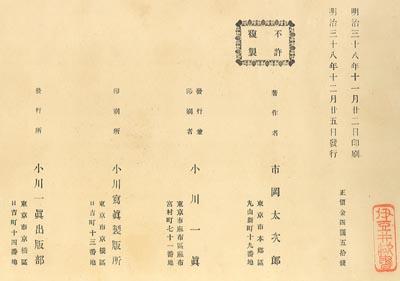
The two rows of charcters at the far right indicate the following (going from the right row to the left).
- Meiji 38 (1905), November 22 - Printed
- Meiji 38 (1905), December 25 - Distributed
|
Index for Russo Japan War, 6 Volume Set |
||
| Naval | Yalu & Karafuto Armies | First Army |
| Second Army | Third Army | Fourth Army |
|
|
||
| Covers | Colophons | Statistics |
|
|
||
|
Return to the K. Ogawa Main Page
For information on a similar 2 volume set, Click here. |
||
|
|
||